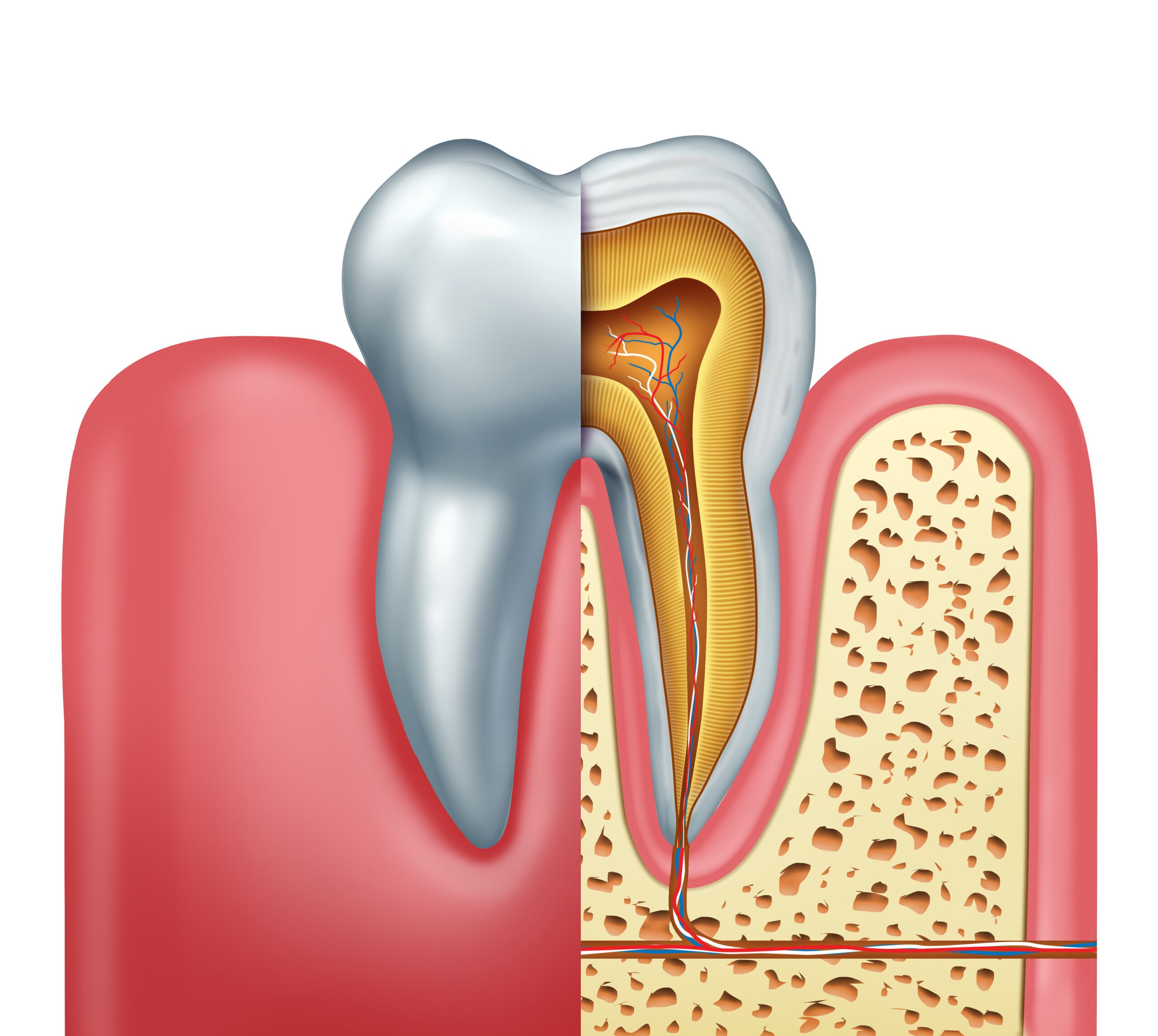In a world where a bright smile is often equated with health, success, and beauty, teeth whitening has become more than just a dental procedure; it’s a global phenomenon. From over-the-counter products to professional dental services, the quest for pearly whites has led to a booming industry. But what exactly is happening when you whiten your teeth? This blog dives deep into the science behind teeth whitening, focusing on how these agents interact with the enamel to brighten your smile.
Understanding Tooth Anatomy
To comprehend how whitening works, it’s essential to understand the anatomy of a tooth. Tooth anatomy is complex and fascinating, with each tooth comprising three primary layers, each serving a unique function. These layers are the enamel, dentin, and pulp. Understanding these layers is crucial to comprehending various dental procedures and conditions, including teeth whitening, cavities, and sensitivity. Here’s a closer look at each layer:
- Enamel
- Description: The enamel is the outermost layer of the tooth. It’s the hardest and most mineralized substance in the human body. Enamel is primarily composed of hydroxyapatite, a crystalline structure made of calcium and phosphate.
- Function: The primary role of enamel is to protect the more sensitive inner layers of the tooth from physical and chemical damage. This includes protection against wear from chewing, and insulation from potentially painful temperatures and chemicals.
- Characteristics: Despite its hardness, enamel is translucent. The color of a tooth is primarily determined by the layer beneath the enamel, known as the dentin. Enamel can be eroded by acids from foods and drinks, as well as from bacterial action.
- Dentin
- Description: Dentin lies beneath the enamel and makes up the bulk of a tooth’s structure. It’s less dense than enamel and is made of microscopic tubules. Dentin is not as hard as enamel but is still quite tough.
- Function: Dentin serves as a secondary layer of protection for the innermost part of the tooth, the pulp. It also supports the enamel and absorbs some of the pressure and stress that teeth endure during chewing.
- Characteristics: Dentin is yellowish and can become more visible if the enamel is worn down or eroded. This is why teeth can appear more yellow as one ages or due to enamel erosion. The tubular structure of dentin is also why teeth can become sensitive; if the enamel wears down, external stimuli like hot or cold temperatures can travel through these tubes to the pulp, causing discomfort.
- Pulp
- Description: The pulp is the innermost layer of the tooth, located in the center. It’s a soft, living tissue that contains nerves, blood vessels, and connective tissue.
- Function: The pulp is responsible for nourishing the tooth during its development and growth. The nerves within the pulp also provide sensory function; they are the reason why you can feel pain in your tooth, for example, due to a cavity reaching the pulp.
- Characteristics: Because it is soft and vulnerable, the pulp is well protected by the dentin and enamel. If bacteria from a cavity reach the pulp, it can lead to infections and abscesses, often resulting in significant pain and requiring treatments like root canal therapy.
Each of these layers plays a vital role in the overall health and functionality of a tooth. Understanding them helps in appreciating the importance of oral hygiene and the impact of dental procedures on tooth structure.
Causes of Tooth Discoloration
Discoloration of teeth can be extrinsic, affecting the outside of the teeth, or intrinsic, affecting the dentin. Extrinsic stains are typically caused by lifestyle factors like smoking, and consuming staining substances like coffee, tea, and red wine. Intrinsic stains, however, can result from aging, exposure to certain medications during tooth formation, or trauma to the teeth. Understanding the type of staining is crucial in selecting the right whitening approach.
Overview of Whitening Agents
The most commonly used whitening agents are hydrogen peroxide and carbamide peroxide. These substances are present in various forms, including whitening strips, gels, and toothpastes, as well as in professional whitening treatments performed by dentists. The concentration of these agents varies depending on the method of application.
Scientific Mechanism of Whitening Agents
At the core of teeth whitening is a chemical reaction. Peroxide-based agents release free radicals when they break down. These radicals interact with the organic compounds causing stains on the enamel, effectively breaking the bonds that hold the stain molecules together. This process, known as oxidation, results in a lighter color.
The concentration of peroxide and the duration of its application play critical roles in the effectiveness of the whitening process. Higher concentrations and longer application times typically yield more dramatic results. However, they also increase the risk of side effects like tooth sensitivity and gum irritation.
Effects on Enamel
While enamel is hard and resilient, it’s not impervious to damage. The peroxide in whitening agents can penetrate the porous structure of enamel. Concerns have been raised about the potential for enamel demineralization and erosion, particularly with high concentrations of whitening agents or excessive use.However, most scientific studies indicate that when used as directed, these products do not cause significant harm to enamel. Still, it’s crucial for users to follow product guidelines and seek professional advice, especially if they have pre-existing dental issues like sensitivity or enamel erosion.
Comparing Whitening Methods
When it comes to teeth whitening, options range from in-office treatments to at-home kits. Professional whitening, performed by dentists, typically involves higher concentrations of peroxide, providing quicker and more noticeable results. Dentists also use additional protective measures, like gum shields, to minimize potential side effects.
At-home kits, while more convenient and cost-effective, generally have lower peroxide concentrations. This means they require more frequent use over a longer period to achieve similar results. The choice between professional and at-home treatments often depends on individual needs, preferences, and dental health.
Role of Other Ingredients
Besides peroxides, teeth whitening products often contain other ingredients that play a supportive role. Desensitizing agents like potassium nitrate help reduce tooth sensitivity, a common side effect of whitening. Fluoride is another additive that can help strengthen tooth enamel and protect against cavities.
Some products also include abrasive ingredients to help physically remove surface stains. While these can enhance the whitening effect, they should be used with caution to avoid excessive wear on the enamel.
Maintenance of Whitened Teeth
Maintaining the results of teeth whitening requires a combination of good oral hygiene and lifestyle adjustments. Regular brushing and flossing are fundamental, as is routine dental cleaning to remove plaque and tartar build-up.
Lifestyle changes, such as reducing the intake of staining foods and beverages, can prolong the whitening effects. For smokers, quitting smoking is not only beneficial for overall health but also crucial in maintaining whiter teeth.
Emerging Trends and Future Research
The field of teeth whitening is continuously evolving, with new products and technologies emerging regularly. Researchers are exploring alternative whitening agents that promise effective results with minimal side effects. Innovations in light-activated and natural whitening treatments are also gaining traction.
Ongoing research is focused on understanding the long-term effects of whitening agents on tooth health and finding ways to enhance the safety and efficacy of whitening treatments.
Conclusion
Teeth whitening, when done correctly, is a safe and effective way to enhance the aesthetic appeal of your smile. Understanding the science behind it, particularly how whitening agents interact with tooth enamel, is crucial in making informed decisions about which method to use.
Whether opting for a professional treatment or an at-home kit, it’s important to consider individual dental health, follow the recommended guidelines, and maintain good oral hygiene practices. As with any dental treatment, consulting with a dental professional is the best way to ensure that you choose the safest and most effective whitening option for your needs.
Through continuous advancements in dental science and technology, teeth whitening is becoming more accessible and tailored to individual preferences and needs, promising a brighter smile without compromising oral health.


